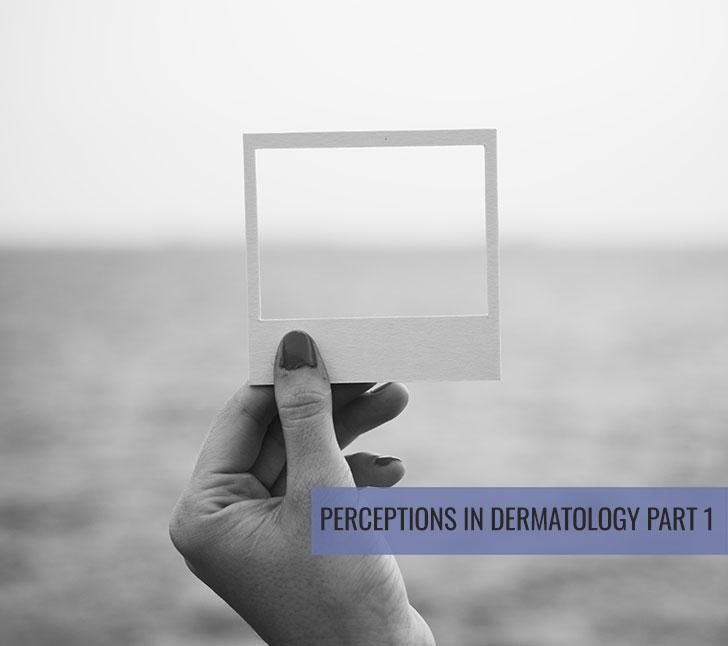In Part I of our two-part series on how dermatology is perceived by outsiders, Dr. Angelo Landriscina explores how the lay public views our specialty.
As dermatologists, we know the importance of the work we do in our communities. We spend our days treating patients with a variety of acute and chronic conditions, helping patients achieve their aesthetic goals, and even helping our inpatient-focused counterparts clinch important diagnoses. While we have the luxury of working in a specialty where one’s area of expertise and style of practice may vary greatly, it is easy to see how each facet of our specialty is important to the patients that we treat and to medicine as a whole. However, the public may not view our careers with the same gravitas that we do, especially since so much of our profession is a mystery to them. I know that since I started my dermatology training, jokes about checking out “this mole on my back” have been thrown my way only slightly more frequently than offers to be my “first patient for Botox.” Even more interestingly, it seems this confusion can extend to physicians in other specialties. I myself have come across non-dermatologist colleagues who had no idea that we were able to do surgical procedures in our specialty or were surprised to see us doing inpatient rounds. These phenomena have lead me to ask: How did our medical colleagues and the public develop these notions about us, and is it ultimately impacting the care that patients receive?
The answer to these questions is quite complex, but I think most of the layperson’s view of dermatologists stems from portrayals in the media. Several of my friends have directed me to a clip from the television show Grey’s Anatomy in which the hard-working, surgical subspecialist protagonists stumble upon a dermatology unit where residents receive massages and sip fruit- infused water all day. Other media portrayals tend to feature dermatologists focused on what seem to be frivolous patient concerns (Dr. Pimple Popper of Instagram and now TV fame) and cosmetic work, sometimes to a damaging degree (The Unbreakable Kimmy Schmidt). This is all in addition to the image that we ourselves may be portraying via the media. Real dermatologists routinely appear on the internet, on television or in print as experts on a particular issue, but more often than not these appearances are focused on “sexier” topics such as cosmetic procedures or skin care products. This is not to mention our own contributions, such as ads for cosmetic services, that regular people may be exposed to on a daily basis. I for one remember seeing TV commercials and subway ads for the services of Dr. Zizmor and his seemingly magical chemical peels while growing up in New York City, and I must admit that they contributed to my preconceived notions of dermatologists, even at a young age.
While we cannot directly measure the impact of the above portrayals of our specialty on public opinion, there have been investigations into how the public perceives dermatologists, and how they may think we stack up against our colleagues in other specialties. One of the most recent investigations of this type by Brezinski et al was published in the Journal of the American Academy of Dermatology in 2014. Through a random sampling and telephone survey, they measured people’s attitudes about dermatologists and how our careers compare to primary care doctors, cardiologists, and plastic surgeons. Out of those surveyed, 46% thought that dermatologists spend a majority of their time treating skin cancer, while 27% believed that they spend most of their time performing cosmetic procedures and 21% responded that a majority of their time is spent treating rashes. The authors point out that this does not match up with dermatology workforce data showing that 63% of direct patient care time is spent managing medical dermatology conditions, followed by 27% spent performing surgery and only 10% of hours spent performing cosmetic procedures.
This study also gauged respondents’ attitudes about the importance of each specialty’s contribution to medicine, and how much they should be paid for their work, and I found these results somewhat unnerving. It turns out that 63% of respondents believed that primary care physicians had a more critical profession than dermatologists and 92% thought that they had a more difficult job. Not surprisingly, 72% of respondents thought that primary care doctors should be paid more than dermatologists. The numbers were even more pronounced when comparing cardiologists to dermatologists, with greater than 99% of those surveyed believing that cardiologists had a more critical and more difficult job and 74% answering that cardiologists deserve a higher salary than dermatologists.
While we cannot necessarily make conclusions about why the public feels how they do about dermatologists, we can make some loose associations. The public thinks that we perform far more cosmetic work than we actually do, that we do not work very long hours or have particularly difficult jobs when compared to many other physicians, and that we should be paid less than our counterparts. I can’t help but conjecture that what patients see in the media and advertising are skewing this perception into what it is. The general public sees portrayals of dermatologists in the media that paint our job as frivolous or unimportant, and as a result, they may view the job of real-life dermatologists as less important. They see an ad or article about aesthetic treatments performed by dermatologists, and as a result, they may see this as the primary focus of our field.
Now, how does this translate to the opinions of other medical professionals? Find out in Part II of our series.
Did you enjoy this article? Find other articles like it by clicking here.

